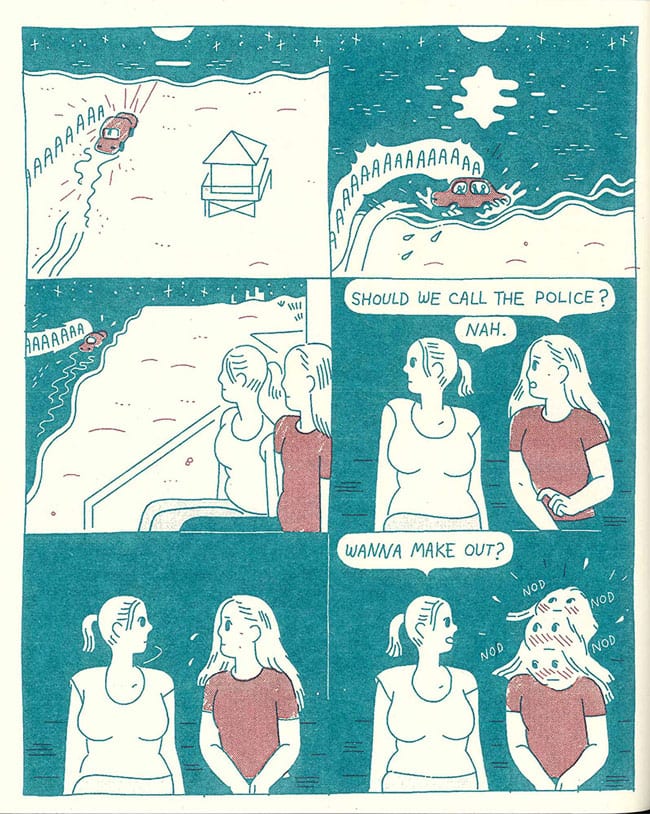Ryans Sands' acclaimed micropress, Youth in Decline, has teamed up with Price Tapes to present this concise, 32-page, two-color risographed anthology of high school romance and angst. The three artists behind Lovers Only—Mickey Zacchilli, Cathy G. Johnson, and Sophia Foster-Dimino—have very different styles and visual aesthetics, but their pieces coalesce into a satisfying whole. Each of their stories features a different nameless young female protagonist, navigating the shoaling waters of high school social dynamics and coping with their desperate attractions to other girls–the romance in these “Teen Romance Comix” being all pretty much of the unrequited variety.
The zine opens with an untitled piece from Johnson, last year's Ignatz Award-winner for Promising New Talent. As in past stories, like Jeremiah and Dear Amanda, Johnson demonstrates an aching empathy for the emotional weather of her protagonists. Here, the heroine secretly yearns for her BFF, who tells her, "If I was a boy I would totally date you!" Our heroine's outwardly breezy response ("I wish I was a boy!") is of course dead serious, though her friend doesn't know (or perhaps doesn't want to know). Our heroine tries to fit in and appears to succeed, but it's easy to see the damage being wrought on her psyche, one denial at a time. When she tells her parents, "I'm not depressed," they respond, "Honey, we believe you, but if you keep repeating it maybe we won't." She abruptly opts out of a date with a boy named Luke, and things take a turn for the worse. Johnson employs the two-color scheme used throughout all three stories in Lovers Only especially well: the protagonist is isolated in reddish-brown against the other characters, who are rendered in pine green. There are no landscapes or backgrounds in the heroine's narrative, underscoring the claustrophobia of her isolation and quiet desperation. Johnson is an acutely perceptive artist.
Mickey Zacchilli contributes the second story, "Acorn High". Her trademark scribbly, chaotic manga-esque lines contribute to the success of this tale, perfectly capturing the underlying chaos and absurdity of high school. "School is in," the sign for Acorn High proclaims, "No Hats Please." Zacchilli's heroine, a person of color, seems much more driven to appear "with it" than the girl in Johnson's previous story, fumblingly smoking a cigarette and putting on shades ("That's it… finally cool"), but she remains just as trapped in the heteronormative high-school social structure. She sits with her best friend Kate, who drills her about the boys she would be willing to date if she had to, making her very uncomfortable. Later, the two girls smoke a joint and numb out. "I had a hard time at Acorn High," our protagonist says, "At the time my frustrations were inarticulable." With her attraction to Kate buried deep inside, she has a different kind of problem than that of Johnson's heroine, who is at least able to be honest with herself (if no one else) about her feelings.
Sofia Foster-Dimino's story, also untitled, takes place on a single night, outside the confines of school or home. Her protagonist accompanies “J,” the strapping, athletic-looking object-of-her-affections, to a beach house, where they go regularly to make out–even though both girls have boyfriends. Though she does at least get some physical affection from her love object, this does nothing for her self-esteem: "I want to tell her how I feel… But I'm a piece of shit." Their canoodling at the beach house is interrupted by a carful of kids whooping it up, reinforcing the furtive, “shameful” nature of the girls’ tryst. Foster-Dimino's art, in contrast to Johnson’s moody tone-poem graphics and Zacchilli’s wild expressionism, is rendered in a straightforward, appealingly cartoony style (a full-color piece of hers in the "Female Secrets" issue of kuš!—also edited by Ryan Sands—reveals much more detailed visuals). Perhaps the single most memorable drawing in the entire book is the last panel on page 28:
That "nod nod nod nod" is adorable, poignant, powerful, and familiar all at once. All three of the Lovers Only artists take the familiar tropes of teen romance and imbue them with new life, mixing the humorously ironic with real emotion, effectively channeling the drama, chaos, and yearning of those fraught years.










